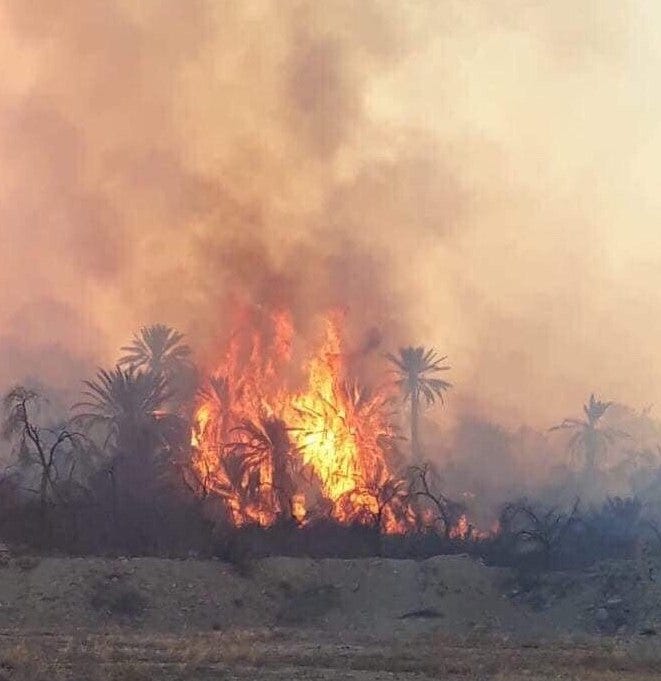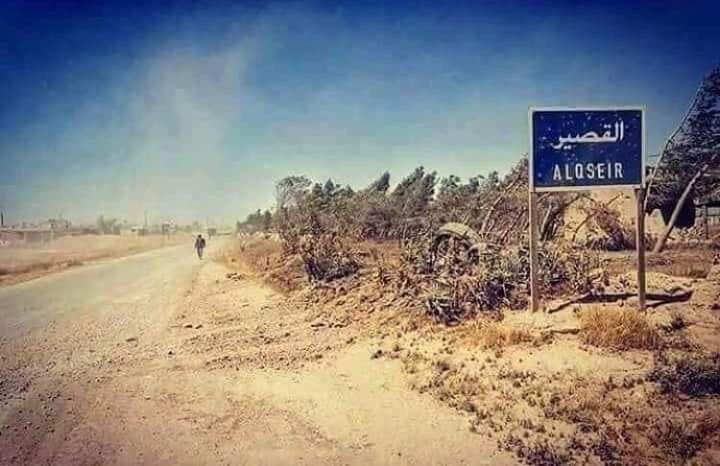
'In a disturbing trend, the Syrian régime and its allies have recently been burning agricultural lands belonging to displaced Syrians with a clear intent to cement their displacement. The systematic nature of the targeting is evident as the fires have been instigated in different areas and governorates under the control of the régime, making it impossible for the displaced to return and harvest the fields and orchards. This text provides a closer look in such incidents in Palmyra, Harasta and Al-Qusayr.
The city of Palmyra is an oasis that adorns the Syrian desert, located northeast of Damascus. It is a UNESCO World Heritage site featuring Roman monuments that bear witness to a great city that was once one of the most important cultural centers of the ancient world. It came under international spotlight when ISIS took control of it and destroyed some of the priceless artefacts, before the régime regained the control of the area.
In May, fires burned agricultural lands in the area near the Meridian Hotel, in the vicinity of the Temple of Antiquities. The sources of the Syrian Association for Citizens’ Dignity in the region confirmed that the fires raged in the area for hours, with the Syrian régime not making any notable effort to control the blaze. According to eyewitnesses, the deliberate failure to deal with these fires might be motivated by the desire to cover up the smuggling of antiquities the régime is carrying out in collusion with Iranian militias.
Our sources reported seeing digging equipment and trucks moving to the area immediately before the fires were started. According to these sources, the militia controlling the area has been excavating for more than two years for the antiquities in the area where the fires occurred. The area where the digging is going on has been sealed off for “security reasons” to prevent civilians from accessing it. The displacement of the local residents is at the same time a tool and a long-term consequence of this criminal effort.
Excavation and smuggling of antiquities from Palmyra is considered an important economic resource that the régime and Iranian militias use to finance the war in Syria. The practice was documented by Al-Quds Al-Arabi newspaper, which reported that “Iranian militias, led by the militia of Al-Najaba and Fatimiyun, began a new exploration campaign on the antiquities in the ancient city of Palmyra and its eastern desert that extended towards Deir Al-Zour, where excavation mechanisms brought in by the militias have been monitored over the past three months.” The area where these excavations started was blocked off to the people who live there, and the route of the motorway Deir Al-Zour-Damascus, which passes near Palmyra, was changed for this purpose.
We have recently reported on the régime’s demolitions of private property in the area of Harasta, in Eastern Ghouta. In the aftermath of that, the local sources reported massive fires in the same area which burned agricultural lands overlooking the Damascus-Homs International Highway during the month of May.
According to this information, members of régime’s forces present in the area intentionally set fire to the surrounding lands in the Panorama area in the city of Harasta, on both sides of the international highway from the Qaboun side, as well as the agricultural lands separating Dahiet Elasad and the Harasta and Barzeh farms.
These recent fires caused great damage to the crops and the trees planted in those lands, especially in the orchards that extend between Harasta and Arabin from the governorate side.
This is not the first time fires have been used to devastate agricultural lands in this area. The eastern Ghouta groves, overlooking the Damascus-Homs international highway, witnessed major fires during May 2019. Thousands of olive trees, some hundreds of years old, were burned in the groves of the Karm Al-Ras area, separating the cities of Duma and Harasta, and the western area of the highway in Harasta. One of the engineers working in the Damascus countryside governorate suggested that the fires are aimed at emptying the agricultural areas and forcing the residents to sell or accept the régime’s expropriation, as part of a plan to include it into the “re-organization” that covers the northern entrance to the capital.
Lastly, at the beginning of April 2020, a big fire broke out in some of the orchards in the villages of Al-Qusayr, a town in the Homs governorate on the border with Lebanon. The area is under control of Hezbollah and the information from the ground suggests that the fires were instigated to clear the land which the militia plans to use to expand its cannabis-growing operation in the area, which is reportedly a major source of income.
The area is of importance to Hezbollah as it has a number of crossings along the border between Lebanon and Syria from the Al-Qusayr side, which are used to transport the loot from Syria which is then sold in the Central Bekaa valley and the southern suburbs of Beirut. Hezbollah also uses the Al-Qusayr region as a training camp for the new recruits deployed in the operations in the Aleppo countryside and Daraa.
With the increasing pressure on Hezbollah in Lebanon as a result of the collapse of the Lebanese economy, Al-Qusayr with its vast green areas is increasingly important to the militia as a source of income and resources. It is for this reason that the southern countryside of Homs remains empty of residents despite several attempts at return of some of those who are displaced in the areas held by the régime, such as the city of Homs or the city of Damascus.
The described practice of burning of agricultural lands in Palmyra, Harasta and Al-Qusayr clearly aim to cement the displacement of the local population by depriving them of a source of livelihood and making their return more difficult. Initial displacement affected by brutal violence and destruction is made worse, with the goal of making it permanent, by the destruction of lands and oases, which then either become settled by members of militia families who live off trafficking (Palmyra), are exploited for cultivation of narcotics (Al-Qusayr) or designated for “re-organization” (Harasta). Or, as was recently the case in the areas of the eastern and southern Idlib countryside and the western countryside of Aleppo, from which people were displaced as a result of the recent military campaign against the Syrian north, the crops sown by the displaced are first harvested by the régime forces and militias, and then set alight.
The pattern of these actions reveals a systematic targeting of the displaced Syrians, which is one of the key causes for the imposition of sanctions by the EU and the US on the régime’s officials and the individuals and entities involved in such criminal conduct. The reversal of these actions, restitution of property and lands to the rightful owners and safe and voluntary return of displaced people who lived on the harvests from the lands devastated by deliberate burning, will be among the basic pre-conditions for the lifting of the sanctions and the possibility of a political solution that guarantees the right to all Syrians.'

No comments:
Post a Comment